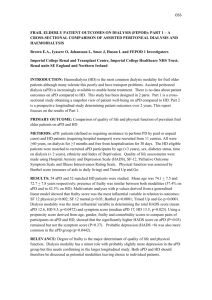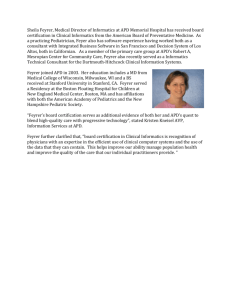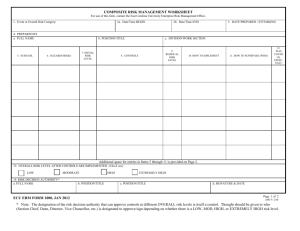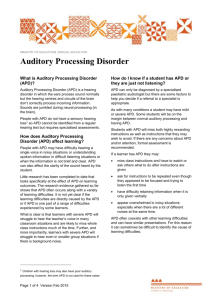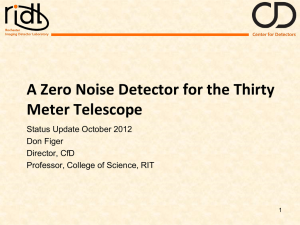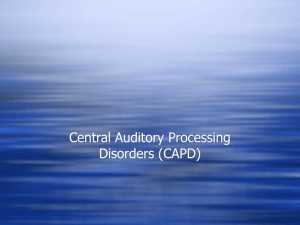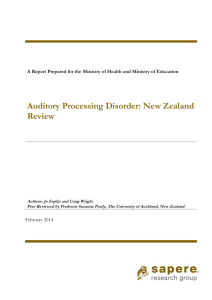Auditory Processing for Teachers of the Deaf
advertisement
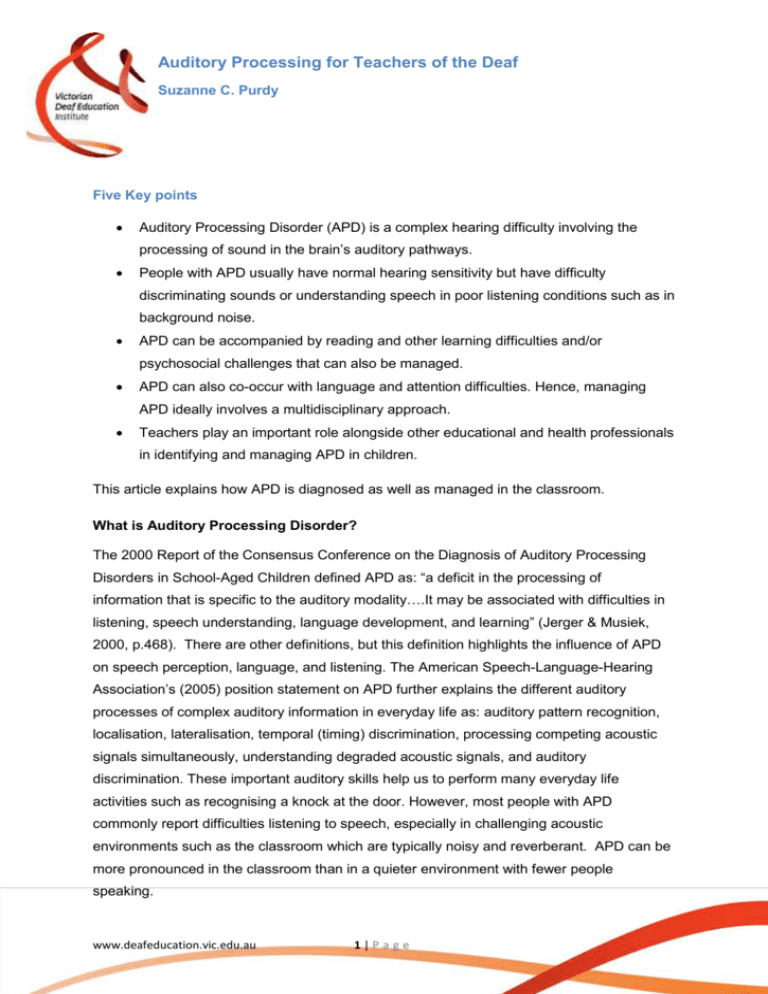
Auditory Processing for Teachers of the Deaf Suzanne C. Purdy Five Key points Auditory Processing Disorder (APD) is a complex hearing difficulty involving the processing of sound in the brain’s auditory pathways. People with APD usually have normal hearing sensitivity but have difficulty discriminating sounds or understanding speech in poor listening conditions such as in background noise. APD can be accompanied by reading and other learning difficulties and/or psychosocial challenges that can also be managed. APD can also co-occur with language and attention difficulties. Hence, managing APD ideally involves a multidisciplinary approach. Teachers play an important role alongside other educational and health professionals in identifying and managing APD in children. This article explains how APD is diagnosed as well as managed in the classroom. What is Auditory Processing Disorder? The 2000 Report of the Consensus Conference on the Diagnosis of Auditory Processing Disorders in School-Aged Children defined APD as: “a deficit in the processing of information that is specific to the auditory modality….It may be associated with difficulties in listening, speech understanding, language development, and learning” (Jerger & Musiek, 2000, p.468). There are other definitions, but this definition highlights the influence of APD on speech perception, language, and listening. The American Speech-Language-Hearing Association’s (2005) position statement on APD further explains the different auditory processes of complex auditory information in everyday life as: auditory pattern recognition, localisation, lateralisation, temporal (timing) discrimination, processing competing acoustic signals simultaneously, understanding degraded acoustic signals, and auditory discrimination. These important auditory skills help us to perform many everyday life activities such as recognising a knock at the door. However, most people with APD commonly report difficulties listening to speech, especially in challenging acoustic environments such as the classroom which are typically noisy and reverberant. APD can be more pronounced in the classroom than in a quieter environment with fewer people speaking. www.deafeducation.vic.edu.au 1|P a g e Effects of APD on children Children diagnosed with APD report a range of difficulties such as words being ‘fuzzy’ or ‘loud’ or ‘sounding the same’. Parents have further reported their child’s loss of confidence, unwillingness to attend school, fatigue, frustration, social difficulties, and, in some cases, depression. Identifying APD in children can be difficult as their challenges and behaviour can be similar to children with Attention Deficit Hyperactivity Disorder (ADHD) or other learning challenges. Children with APD can have trouble comprehending spoken language unless brief statements and simple sentence constructions are used. They may also be slow to process spoken information and have particular trouble listening in noisy environments or when many people are speaking at the same time. This differs from the typical profile of children with ADHD. Diagnosing APD Clinical audiologists diagnose APD by testing different auditory processes to see whether performance differs from age-norms. This usually involves a standard hearing test battery followed by more complex listening tests that require the child to hear small changes in sound or hear sounds in both ears at the same time. Most current clinical APD tests are suitable for children aged 7 years and older. However, many widely used standardised APD tests with good normative data are available for audiologists to assess children as young as 5-6 years. Early identification of APD is important in order to provide intervention that assists the child’s academic progress, self-esteem and social development. Questionnaires are also available to teachers and parents to help identify everyday listening difficulties experienced by children with APD. Cognition, language and auditory processing Children with APD can have attention and/or auditory memory difficulties that need to be separately assessed to determine whether a child has APD alone or additional cognitive difficulties. Many children with APD (40-50%) also have co-occurring language and reading difficulties, which should also be assessed separately. Children with APD are likely to have poor phonological processing because of difficulties discriminating speech sounds. There are a number of evidence-based treatments for phonological difficulties that can assist children with APD. Management Managing APD should include direct therapy to enhance the child’s resources, optimizing their listening environment (e.g. by improving room acoustics), and enhancing the auditory signal (e.g. with remote microphone hearing aids [RMHAs]), and teaching coping and problem-solving strategies (e.g., metacognitive strategies). Evidence supports APD treatments including RMHAs (also referred to as ‘personal FM’) and direct therapy to www.deafeducation.vic.edu.au 2|P a g e manage dichotic or spatial listening difficulties. For example, an evidence-based computer training program for managing spatial processing difficulties has been developed at the National Acoustic Laboratories in Australia. Research further attests to other effective computer-based training programs for improving auditory discrimination. However, more research is needed to know whether these programs improve other areas such as reading and language. Teachers Teachers have a key role in successfully identifying and supporting children with APD. Teachers can manage the classroom’s acoustic and visual environment to improve the child’s listening and learning. They can also use listening technologies (e.g., RMHAs) and use visual strategies to help children with APD listen and understand classroom instructions and information. Encouraging listening games may help children to think more about their wider auditory environment and to engage in listening. Greater collaboration between teachers, audiologists and other professionals working with children with hearing difficulties will further help children with APD to maximise their potential. References ASHA (2005). (Central) Auditory Processing Disorders—The Role of the Audiologist [American Speech-LanguageHearing Association Position statement]. Available at http://www.asha.org/members/deskref-journals/deskref/default. 2005. www.deafeducation.vic.edu.au 3|P a g e
